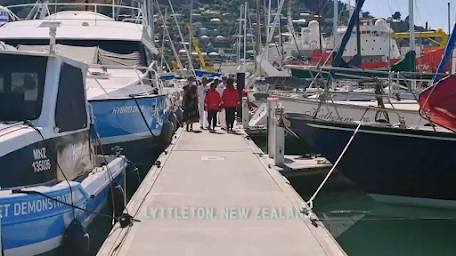Indian Navy circumnavigation
Lieutenant Commanders Roopa A and Dilna K Lead a Trailblazing Voyage Around the Globe
Discover the remarkable journey of Lieutenant Commanders Roopa A and Dilna K as they undertook a historic circumnavigation of the globe aboard the Indian Naval Sailing Vessel INSV Tarini. This exceptional voyage showcases resilience, adventure, and the spirit of Nari Shakti in the maritime domain.
Lt Commander Roopa A and Lt Commander Dilna K, two pioneering women officers of the Indian Navy, undertook a historic circumnavigation of the globe. They covered a distance of 25,600 nautical miles (approximately 50,000 kilometres) across four continents, three oceans, and three Great Capes aboard the Indian Naval Sailing Vessel INSV Tarini. Their journey, braving extreme weather conditions and challenging seas, relying solely on sails and wind power, exemplifies the prowess of Nari Shakti in the maritime domain and serves as an inspiration to all.
 |
| Screengrab from a video shared by the Indian Navy. Credit: X/@indiannavy |
This impressive vessel boasts six sails, including the mainsail, genoa, staysail, downwind sail, and storm sail, allowing it to navigate effectively across various maritime conditions, including extreme weather scenarios. The overall length of the boat is 56 feet, and it features a towering mast that stands approximately 25 meters tall.
Tarini, while sharing similarities with her predecessor, the INSV Mhadei, incorporates several enhancements that have been carefully designed based on the valuable experience gained from operating the INSV Mhadei. This modern sailboat is equipped with a host of advanced features that significantly enhance its functionality, including state-of-the-art satellite communications systems, a comprehensive Raymarine navigation suite, and a Monitor wind vane specifically designed to ensure reliable steering in emergencies. These attributes collectively enhance Tarini's operational efficiency and safety on the water, leaving a lasting impression of its advanced capabilities.
For the Indian Navy, the voyage symbolised the spirit of adventure and resilience that defines the Indian Navy, expressing complete confidence in the capabilities of the two women officers on their historic journey. The transoceanic expedition of INSV Tarini marked a significant stride forward in India's maritime endeavours, showcasing the nation's growing prominence in global maritime activities and advocating for gender equality at sea. It stands as a testament to the Indian Navy's commitment to fostering excellence and diversity within its ranks, underscoring the importance of this historic achievement.
Lt Cdrs Dilna and Roopa commenced their voyage from Goa on October 2, 2024. They braved the elements for over eight months, negotiating the 'roaring forties', 'furious fifties' and 'screaming sixties' all alone. They began the circumnavigation with port calls at Fremantle (Australia) and proceeded to Lyttleton (New Zealand), Port Stanley (Falkland Islands) and Cape Town (South Africa) before returning home.
The crew encountered three cyclones, navigated through the treacherous Drake Passage and successfully rounded Cape Horn. They encountered winds of up to 50 knots (93 km/h) coupled with stormy weather conditions and frigid temperatures during the journey, setting the ultimate test of human endurance, perseverance, and sailing skills.
Despite the unique challenges posed by each leg of the journey, the third leg from Lyttleton to Port Stanley proved to be the most gruelling.
 |
| Fremantle (Australia) Port |
"There are seldom records of anyone reaching the exact coordinates of Point Nemo — the ocean's most isolated point from any land, where the nearest humans are aboard the space station. Yet, for us Indians, that remoteness is a thing of the past. Consider the Drake Passage and rounding Cape Horn — the Everest of every sailor, both a pinnacle and a nightmare. Halfway around the world, the sea humbled us. It turned us into students once again," Dilna expressed passionately.
The officers vividly recalled a harrowing night when, while desperately trying to navigate away from a cyclone, they experienced a "complete navigation panel blackout" in the heart of the Pacific Ocean. "We lost GPS, boat heading, wind instruments, autopilot… it took us three agonising hours to regain control of our systems, but it felt like an eternity," Lt Cdr. Roopa recounted.
 |
| Lyttleton (New Zealand) Credit: X/@indiannavy |
"We witnessed the ocean in its fury, with waves towering 20 feet high crashing against us like unyielding walls. Yet, we also experienced days when the sea lay as calm as glass… and we endured it all in the relentless cold that nearly froze us. The world of the sea… It's the same planet, yet an entirely different realm out there. I have watched the ocean glow at night, the sky adorned with galaxies, shooting stars illuminating the darkness, a profound stillness that brings both mind and body to peace," she mentioned, her voice filled with wonder.
"Yes, we made it!" exclaimed Lieutenant Commander Dilna K., her joy radiating.
"I feel as if I have lived all seven of my lives within these eight months," declared Lieutenant Commander Roopa A., her spirit undeterred.
With these powerful words, the two remarkable women officers of the Indian Navy triumphantly arrived at Goa's Mormugao port aboard INSV Tarini on May 29 2025, forever etching their names in history. Their arrival was met with a grand welcome ceremony attended by none other than India's Defence Minister Rajnath Singh.
This reflects the crew's unwavering determination and resilience in the face of extreme challenges, inspiring all who hear their story.
During the voyage, Lt Cdrs Dilna and Roopa crossed Point Nemo – the remotest location on earth – in the southern Pacific, which is nearly 2,700 km from the nearest landmass in January. This isolated point is renowned for its extreme remoteness, with the closest human presence often being aboard the International Space Station, which orbits above. The expedition has been a defining chapter in India's maritime history. The crew exemplified the spirit of exploration, showcasing seafaring skills on a global stage.